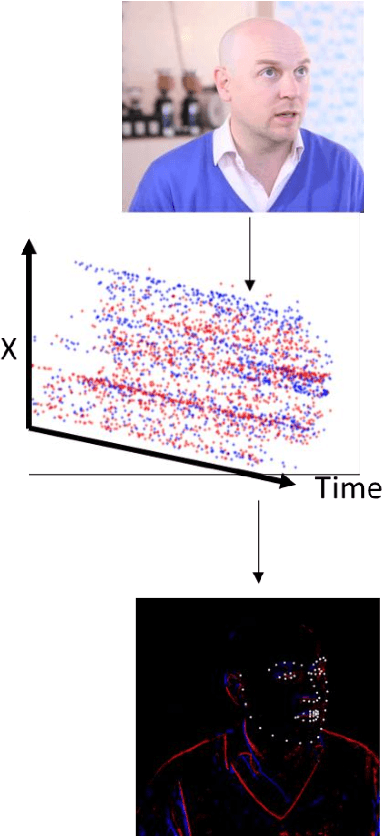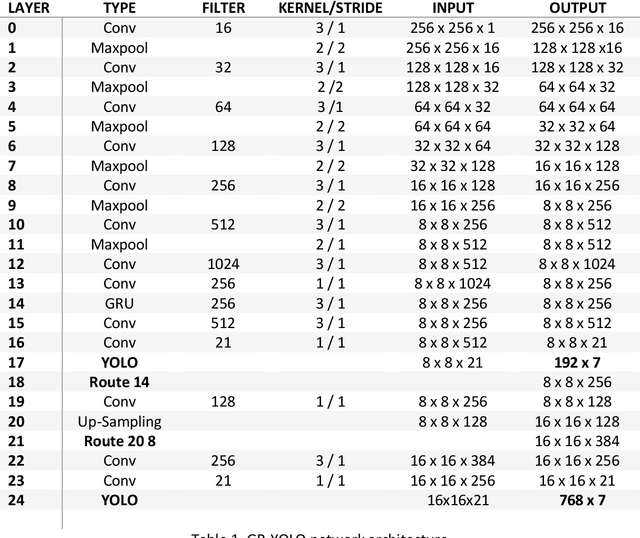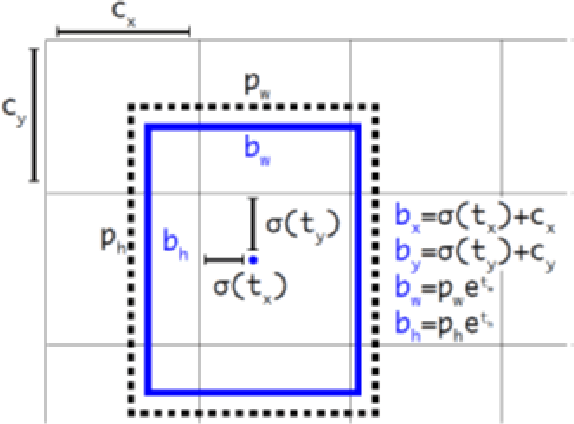Christoph Posch
An Event-Based Digital Compute-In-Memory Accelerator with Flexible Operand Resolution and Layer-Wise Weight/Output Stationarity
Oct 30, 2024Abstract:Compute-in-memory (CIM) accelerators for spiking neural networks (SNNs) are promising solutions to enable $\mu$s-level inference latency and ultra-low energy in edge vision applications. Yet, their current lack of flexibility at both the circuit and system levels prevents their deployment in a wide range of real-life scenarios. In this work, we propose a novel digital CIM macro that supports arbitrary operand resolution and shape, with a unified CIM storage for weights and membrane potentials. These circuit-level techniques enable a hybrid weight- and output-stationary dataflow at the system level to maximize operand reuse, thereby minimizing costly on- and off-chip data movements during the SNN execution. Measurement results of a fabricated FlexSpIM prototype in 40-nm CMOS demonstrate a 2$\times$ increase in bit-normalized energy efficiency compared to prior fixed-precision digital CIM-SNNs, while providing resolution reconfiguration with bitwise granularity. Our approach can save up to 90% energy in large-scale systems, while reaching a state-of-the-art classification accuracy of 95.8% on the IBM DVS gesture dataset.
Photonic Neuromorphic Accelerators for Event-Based Imaging Flow Cytometry
Apr 16, 2024Abstract:In this work, we present experimental results of a high-speed label-free imaging cytometry system that seamlessly merges the high-capturing rate and data sparsity of an event-based CMOS camera with lightweight photonic neuromorphic processing. This combination offers high classification accuracy and a massive reduction in the number of trainable parameters of the digital machine-learning back-end. The photonic neuromorphic accelerator is based on a hardware-friendly passive optical spectrum slicing technique that is able to extract meaningful features from the generated spike-trains. The experimental scenario comprises the discrimination of artificial polymethyl methacrylate calibrated beads, having different diameters, flowing at a mean speed of 0.01m/sec. Classification accuracy, using only lightweight, digital machine-learning schemes has topped at 98.2%. On the other hand, by experimentally pre-processing the raw spike data through the proposed photonic neuromorphic spectrum slicer we achieved an accuracy of 98.6%. This performance was accompanied by a reduction in the number of trainable parameters at the classification back-end by a factor ranging from 8 to 22, depending on the configuration of the digital neural network.
NeuroBench: Advancing Neuromorphic Computing through Collaborative, Fair and Representative Benchmarking
Apr 15, 2023



Abstract:The field of neuromorphic computing holds great promise in terms of advancing computing efficiency and capabilities by following brain-inspired principles. However, the rich diversity of techniques employed in neuromorphic research has resulted in a lack of clear standards for benchmarking, hindering effective evaluation of the advantages and strengths of neuromorphic methods compared to traditional deep-learning-based methods. This paper presents a collaborative effort, bringing together members from academia and the industry, to define benchmarks for neuromorphic computing: NeuroBench. The goals of NeuroBench are to be a collaborative, fair, and representative benchmark suite developed by the community, for the community. In this paper, we discuss the challenges associated with benchmarking neuromorphic solutions, and outline the key features of NeuroBench. We believe that NeuroBench will be a significant step towards defining standards that can unify the goals of neuromorphic computing and drive its technological progress. Please visit neurobench.ai for the latest updates on the benchmark tasks and metrics.
Real-Time Face & Eye Tracking and Blink Detection using Event Cameras
Oct 16, 2020



Abstract:Event cameras contain emerging, neuromorphic vision sensors that capture local light intensity changes at each pixel, generating a stream of asynchronous events. This way of acquiring visual information constitutes a departure from traditional frame based cameras and offers several significant advantages: low energy consumption, high temporal resolution, high dynamic range and low latency. Driver monitoring systems (DMS) are in-cabin safety systems designed to sense and understand a drivers physical and cognitive state. Event cameras are particularly suited to DMS due to their inherent advantages. This paper proposes a novel method to simultaneously detect and track faces and eyes for driver monitoring. A unique, fully convolutional recurrent neural network architecture is presented. To train this network, a synthetic event-based dataset is simulated with accurate bounding box annotations, called Neuromorphic HELEN. Additionally, a method to detect and analyse drivers eye blinks is proposed, exploiting the high temporal resolution of event cameras. Behaviour of blinking provides greater insights into a driver level of fatigue or drowsiness. We show that blinks have a unique temporal signature that can be better captured by event cameras.
HFirst: A Temporal Approach to Object Recognition
Aug 05, 2015



Abstract:This paper introduces a spiking hierarchical model for object recognition which utilizes the precise timing information inherently present in the output of biologically inspired asynchronous Address Event Representation (AER) vision sensors. The asynchronous nature of these systems frees computation and communication from the rigid predetermined timing enforced by system clocks in conventional systems. Freedom from rigid timing constraints opens the possibility of using true timing to our advantage in computation. We show not only how timing can be used in object recognition, but also how it can in fact simplify computation. Specifically, we rely on a simple temporal-winner-take-all rather than more computationally intensive synchronous operations typically used in biologically inspired neural networks for object recognition. This approach to visual computation represents a major paradigm shift from conventional clocked systems and can find application in other sensory modalities and computational tasks. We showcase effectiveness of the approach by achieving the highest reported accuracy to date (97.5\%$\pm$3.5\%) for a previously published four class card pip recognition task and an accuracy of 84.9\%$\pm$1.9\% for a new more difficult 36 class character recognition task.
* 13 pages, 10 figures
 Add to Chrome
Add to Chrome Add to Firefox
Add to Firefox Add to Edge
Add to Edge